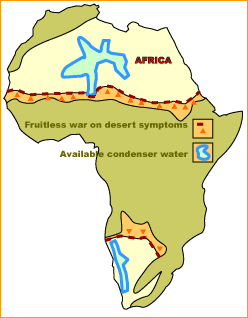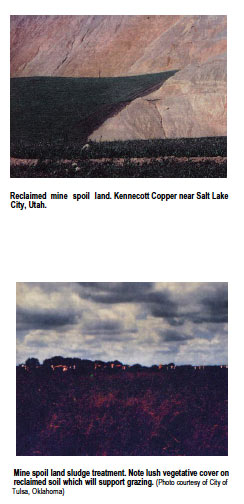Archive for the ‘Africa’ Category
Plant respiration= evaporation cooling
Plant respiration = evaporation cooling.
Evaporation cooling = moist southern air moving north.
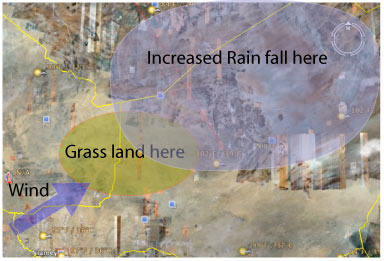
Water flows down hill… in ancient river beds under the sand.
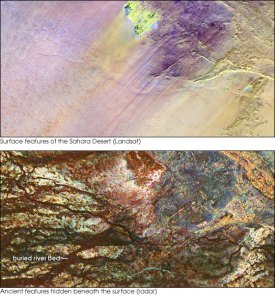
Big Picture
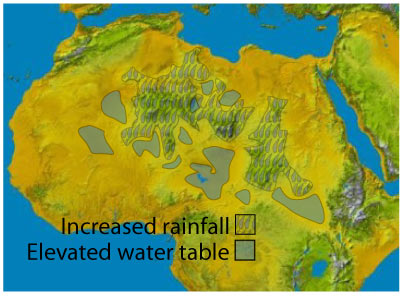
Data from the Soil Conservation Research project at McCredie during the summer drought of 1953 showed the corn crop exhausting the soil moisture to a depth of 3.5 feet under the fertilized soils. The equivalent of only 1.04 inches of water was left in that entire depth. Where the soil was not fertilized, the crop dried out the soil to a lesser depth. It left the equivalent of 4.5 inches of water in the upper 3.5 feet.
On the unfertilized corn, which took 14 inches of water from the soil, the yield was only 18 bushels per acre. It required 26,000 gallons of water to make a bushel of corn. On the fertilized soil with a yield of 79 bushels, only 5,600 gallons of water per bushel were required.The drought was a case of plant hunger rather than thirst.
Or simply, 4 times the crop yeild with one fifth the amount of water on fertile soil.
Biosolids and grass seed: more crop less water.
Strategic Difference
The strategic difference in this plan is: Rather than addressing expanding desertification unsuccessfully at the margins of the Sahara ( symptoms ) this plan calls for addressing the root cause of desertification: failure of the Tibesti and Ahaggar fresh water function to be self sustaining due to soil depletion, savanna and forest loss, or more simply, insufficient ground nutrients to self sustain a stronger water cycle.
Over grazing = desert
Grass and Biosolid – We may want to consider the possibility that converting savanna grass lands to desert over the past 6,000 years of agricultural empire building is responsible for climate change effects rather than the reverse view that climate change causes deserts.
The Future Looks Like Bio Solids
India scoops uranium contract.
“In return for the permit, Taurian Resources promised the Government of Niger that the company will green one million hectares of land”
Dung + grass = everything else for nomads. That includes fixing ground and air ( dust ) uranium.
Bacillus subtilis is a Gram-positive, catalase-positive bacterium commonly found in soil.[1] A member of the genus Bacillus, B. subtilis has the ability to form a tough, protective endospore, allowing the organism to tolerate extreme environmental conditions. Unlike several other well-known species, B. subtilis has historically been classified as an obligate aerobe, though recent research has demonstrated that this is not strictly correct.[2]
It has also been called Bacillus globigii, Hay bacillus or Grass bacillus.
“These results suggest that the bacteria have a higher affinity for U than the kaolinite clay mineral under the experimental conditions tested, and that they can immobilize significant amounts of uranium.”
Kaolinite has a high affinity for U and Grass Bacillus affinity is even higher.
Soil bacteria require real ( dung ) fertilizers and soil; the fakes won’t do.
U mine contamination can be managed with biosolids and grass applied at the pit and in the surrounding areas.
Biosolids.
Fertile soil uses much, much less water to grow much, much more crop.
Sand Dams
Daily Motion Video on sand dams.
Grass lands eliminated toxic dust storms.
Dr. Karl L. Wuensch’s brief dust storm blurb.
Big Water and Grass – Africa
Biosolid application methods and design factors
Commentary by Mr. Luc Gnacadja, Executive Secretary of the United Nations Convention to Combat Desertification on the occasion of The TICAD IV Breakout session D: Addressing environmental issues/ climate change
29 May 2008, Yokohama, Japan
It is an honour for me to contribute to the work of this session.
Desertification means land degradation caused by various factors including climatic variations and human activities. According to the report of the Millennium Ecosystem Assessment, climate change is aggravating desertification, making it “the greatest environmental challenge of our times and a major impediment to meeting basic human needs in drylands.” In the Africa region, the issue is of serious concern, given that some 60 per cent of the population depends on agriculture and the land degradation processes affect about 46 per cent of the whole continent.
UNEP estimates that desertification costs some 9 billion US dollars a year in Africa alone. Further, a recent study indicated that land degradation on arable land is taking place in the most productive areas of sub-Saharan Africa, threatening food production in the long-run.
This already grim situation has been aggravated recently due to the sharp rise of food prices. It is striking that the geography of endemic poverty and hunger coincides with that of degraded lands. In fact, “today’s global challenges such as the food crisis, the consequences of biofuels on land and food commodities, the water scarcity, the forced migrations and other threats of climate change, are bringing the global community down to earth, down to the land. They are calling for sound and integrated policies including on sustainable land management”. I want to highlight that “reforming policies to combat desertification also represents one of the world’s most expedient ways to sequester more atmospheric carbon and help address the climate change issue” according to the UNU. So at the UNCCD, the UNMEA in charge of monitoring the sustainable management of land, we are calling for actions on the following:
1. Reject the notion that aridity and water scarcity are inevitable;
2. Create financial incentives for pastoralists and other dryland users to preserve and enhance the ecosystem services their land provides to all;
3. Accept the carbon sequestration as a measure for simultaneously combating desertification and climate change;
4. Foster alternative, sustainable livelihoods for dryland dwellers, including non-agricultural jobs;
5. Yield ownership and decision making to communities: empower them to take charge of land on which they depend and end the pattern of individuals chasing environmentally detrimental short-term gains;
Vast Sahara aquifers
An international team worked on the verge of the Sahara to gather data on the ground and in the air, to be compared with imagery of the same region acquired by ESA satellites. The results will be used in support of an ambitious project to apply satellite remote sensing to improve monitoring and management of vast water aquifers concealed beneath the desert.
Tuareg
Unhappy nomadic herders are happier with grass land and large healthy herds.
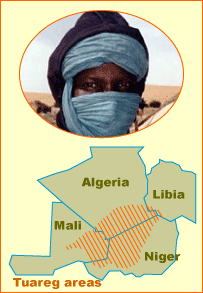
What it looks like.
The difference in productivity of biosolid treated land and non treated side by side. BIG WATER AFRICA
Nature
The Saharan capacity, about 5 million square miles, for storing soil nutrients is foreseeably not limited and restoration of former Savanna by various groups in several Saharan countries, and elsewhere, have thus far made only small gains in what appears for them to be an intractable problem. Spending billions on “nature mimicking” sewage treatment plants while depriving soil and grass land of nutrients is just plain silly.
Small scale local clean water
DIY. Solar, potable water condenser anyone can make to:
Convert salt water to fresh.
Polluted water to clean
On any scale:
Bright Future
Four problems one solution.
Desertification
Global warming/cooling
Biosolid disposal
Uranium contamination
Global Cooling
Is possible. More
The strategic difference in this plan is: “Rather than addressing expanding desertification unsuccessfully at the margins of the Sahara ( symptoms ) this plan calls for addressing the root cause of desertification: failure of the Tibesti and Ahaggar fresh water function to be self sustaining due to soil depletion, savanna and forest loss, or more simply, insufficient plant food and ground water to self sustain.”
Have a Happy New Year!!!
hbmt
